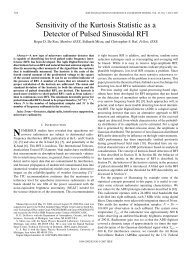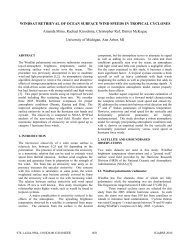Jason Microwave Radiometer performance and on-orbit - Remote ...
Jason Microwave Radiometer performance and on-orbit - Remote ...
Jason Microwave Radiometer performance and on-orbit - Remote ...
Create successful ePaper yourself
Turn your PDF publications into a flip-book with our unique Google optimized e-Paper software.
<str<strong>on</strong>g>Jas<strong>on</strong></str<strong>on</strong>g> <str<strong>on</strong>g>Radiometer</str<strong>on</strong>g> Performance <str<strong>on</strong>g>and</str<strong>on</strong>g> Calibrati<strong>on</strong> 217The uncertainty of the JMR PD can be determined by subtracting the RaOb errorfrom the estimate of RMS PD difference at zero spatial separati<strong>on</strong> (with minimal temporalseparati<strong>on</strong>). The uncertainty in the radios<strong>on</strong>de humidity profile is estimated to be 0.7 cm(Alishouse et al. 1990). This is most likely a c<strong>on</strong>servative estimate, but it will be used becausea higher value will decrease the estimated JMR PD error. Also, this is the radios<strong>on</strong>de errorestimate that was used to determine the uncertainty of the TMR PD measurement, so itwill allow for easy comparis<strong>on</strong>s of the PD uncertainty of the two instruments. Using thisestimate, Equati<strong>on</strong> 11 is used to determine the uncertainty of the JMR PD measurement.The RMS error estimate of 1.02 cm from Figure 6 has error bars of approximately ±0.1cm. Thus the uncertainty of the 1-sec<strong>on</strong>d JMR PD measurement is estimated to be 0.74 cm± 0.15 cm. The uncertainty in the JMR PDs is better than the 1.2 cm missi<strong>on</strong> requrement.Summary <str<strong>on</strong>g>and</str<strong>on</strong>g> C<strong>on</strong>clusi<strong>on</strong>sThe <str<strong>on</strong>g>Jas<strong>on</strong></str<strong>on</strong>g> <str<strong>on</strong>g>Microwave</str<strong>on</strong>g> <str<strong>on</strong>g>Radiometer</str<strong>on</strong>g> is included <strong>on</strong> the <str<strong>on</strong>g>Jas<strong>on</strong></str<strong>on</strong>g>-1 Ocean Altimetry satellite tomeasure the wet tropospheric path delay of the altimeter signal. Accurate retrieval of thepath delay values requires well-calibrated brightness temperatures <str<strong>on</strong>g>and</str<strong>on</strong>g> a precise inversi<strong>on</strong>algorithm. The JMR TBs are calibrated <strong>on</strong>-<strong>orbit</strong> over the entire dynamic range of theinstrument. The TBs are calibrated at the cold end of the TB range by using a vicariouscold reference, which represents a statistical lower bound <strong>on</strong> brightness temperature. TheTBs are calibrated at the hot end of the TB range using hot reference TBs determined fromSSM/I over heavily vegetated regi<strong>on</strong>s of the Amaz<strong>on</strong> rainforest.The retrieved path delay values are validated using collocated TMR <str<strong>on</strong>g>and</str<strong>on</strong>g> RaOb derivedPD values. There is no significant bias between the JMR <str<strong>on</strong>g>and</str<strong>on</strong>g> TMR PDs <str<strong>on</strong>g>and</str<strong>on</strong>g> no error thatscales with path delay. This is also c<strong>on</strong>firmed independently by the comparis<strong>on</strong> with theRaOb derived PD values. There are no noticeable biases in cloudy or windy c<strong>on</strong>diti<strong>on</strong>sbetween the JMR <str<strong>on</strong>g>and</str<strong>on</strong>g> RaOb PDs <str<strong>on</strong>g>and</str<strong>on</strong>g> no scale errors.The uncertainty of the JMR PD measurement can be estimated in two ways. First, theRMS difference between the JMR <str<strong>on</strong>g>and</str<strong>on</strong>g> TMR PDs is largely explained by the stochastic noiseof the recievers, <str<strong>on</strong>g>and</str<strong>on</strong>g> the remaining difference is explained by the difference in the <strong>on</strong>-Earthsidelobe brightness used in the APC <str<strong>on</strong>g>and</str<strong>on</strong>g> the spatial decorrelati<strong>on</strong> of the measurement. Theuncertainty in the JMR PDs can also be estimated from the RaOb PD comparis<strong>on</strong>s. The RMSdifference between the JMR <str<strong>on</strong>g>and</str<strong>on</strong>g> RaOb PDs is a functi<strong>on</strong> of the RaOb error, JMR error, <str<strong>on</strong>g>and</str<strong>on</strong>g>the spatial <str<strong>on</strong>g>and</str<strong>on</strong>g> temporal decorrelati<strong>on</strong> between them. The RMS difference is extrapolated tozero spatial separati<strong>on</strong> at minimum temporal separati<strong>on</strong>. The error in the RaOb measurementis removed from the remaining RMS difference, leaving <strong>on</strong>ly effects of the JMR PD error.The uncertainty of the JMR PD measurement is estimated to be 0.74 cm ± 0.15.ReferencesAlishouse, J. C., S. A. Snyder, J. V<strong>on</strong>gsathorn, <str<strong>on</strong>g>and</str<strong>on</strong>g> R. R. Ferraro. 1990. Determinati<strong>on</strong> of oceanictotal precipitable water from SSM/I. IEEE Trans. Geosci. Rem. Sensing 28:811–816.Boudouris, G. 1963. On the index of refracti<strong>on</strong> of air, the absorpti<strong>on</strong> <str<strong>on</strong>g>and</str<strong>on</strong>g> dispersi<strong>on</strong> of centimeterwaves by gasses. J. Res. Natl. Bur. St<str<strong>on</strong>g>and</str<strong>on</strong>g>. Sect. D. 67: 631–684.Brown, S., <str<strong>on</strong>g>and</str<strong>on</strong>g> C. Ruf. 2003. On-<strong>orbit</strong> microwave blackbody calibrati<strong>on</strong> using regi<strong>on</strong>s of densevegetati<strong>on</strong>. IGARSS 2003 C<strong>on</strong>f. Proc.Brown, S., C. Ruf, <str<strong>on</strong>g>and</str<strong>on</strong>g> S. Keihm. 2002. Brightness temperature <str<strong>on</strong>g>and</str<strong>on</strong>g> path delay correcti<strong>on</strong> for TOPEXmicrowave radiometer yaw state bias. Technical Memo, 8 August 2002.Cruz-Pol, R. C. Ruf, <str<strong>on</strong>g>and</str<strong>on</strong>g> S. Keihm. 1998. Improved 20–32 GHz atmospheric absorpti<strong>on</strong> model. RadioSci. 22(5):1319–1333.Ellis<strong>on</strong> W., A. Balana, G. Delbos, K. Lamkaouchi, L. Eymard, C. Buillou, <str<strong>on</strong>g>and</str<strong>on</strong>g> C. Prigent. 1998. Newpermittivity measurements of seawater. Radio Sci. 33(3):639–648.





